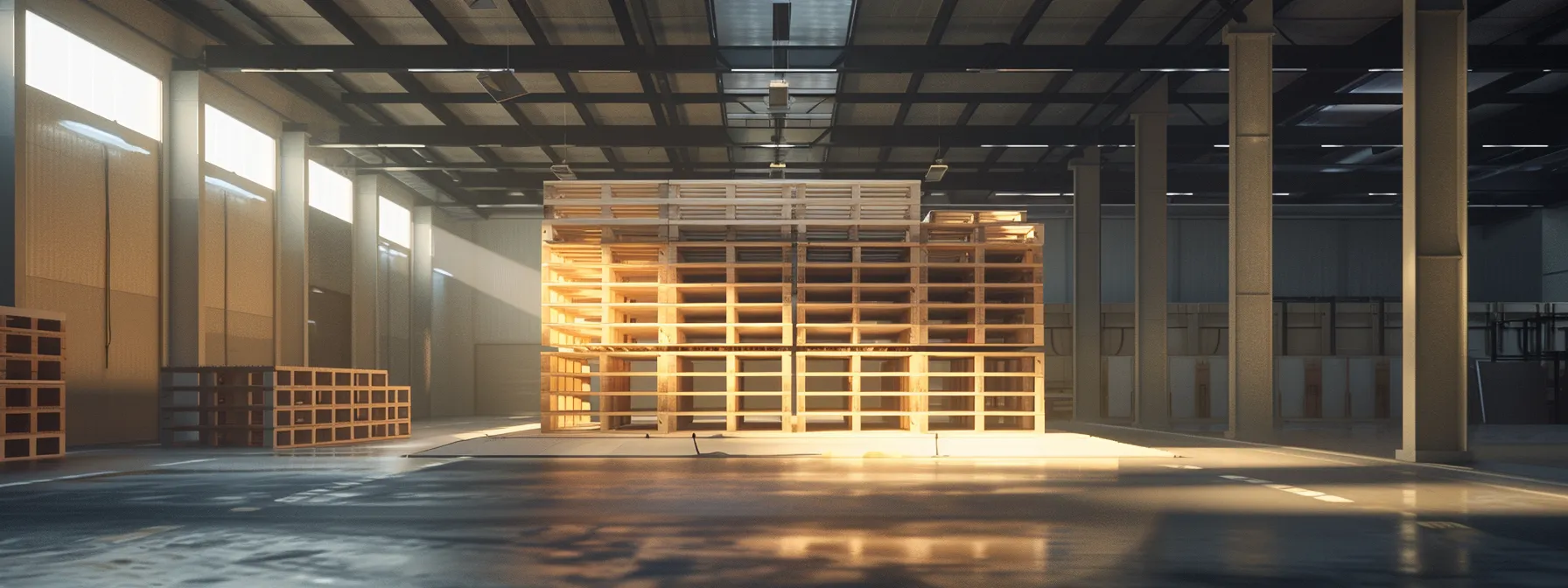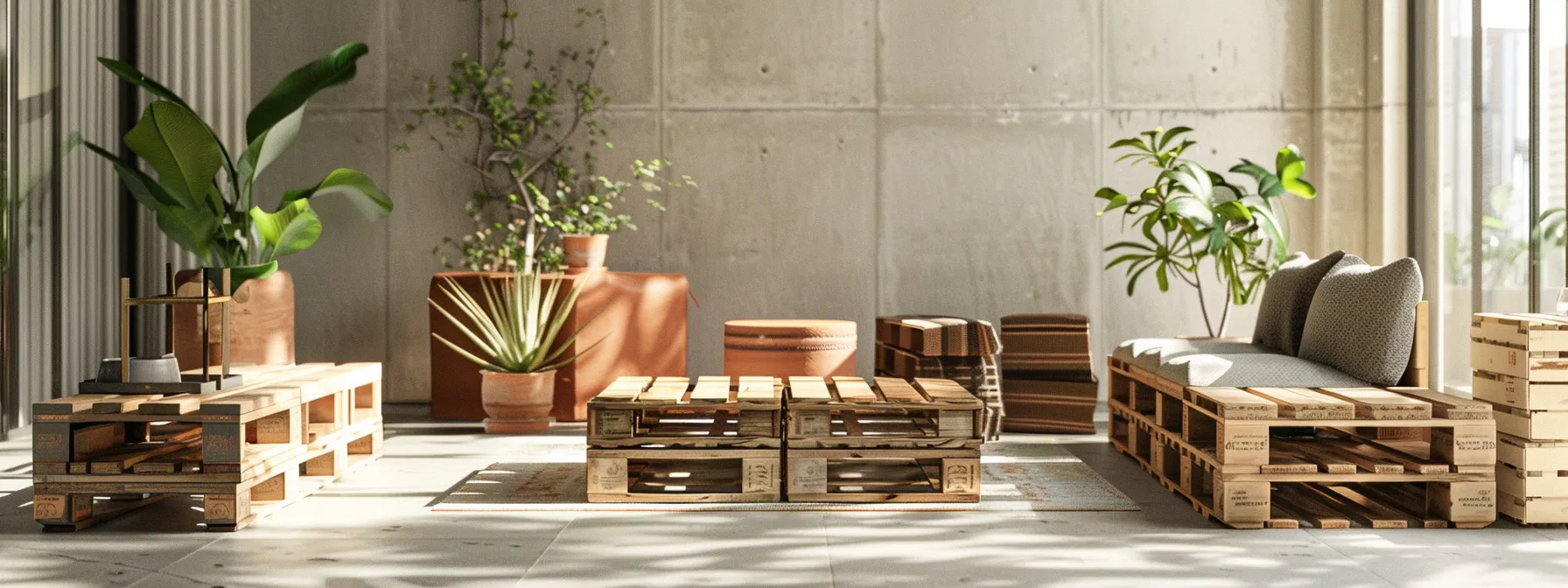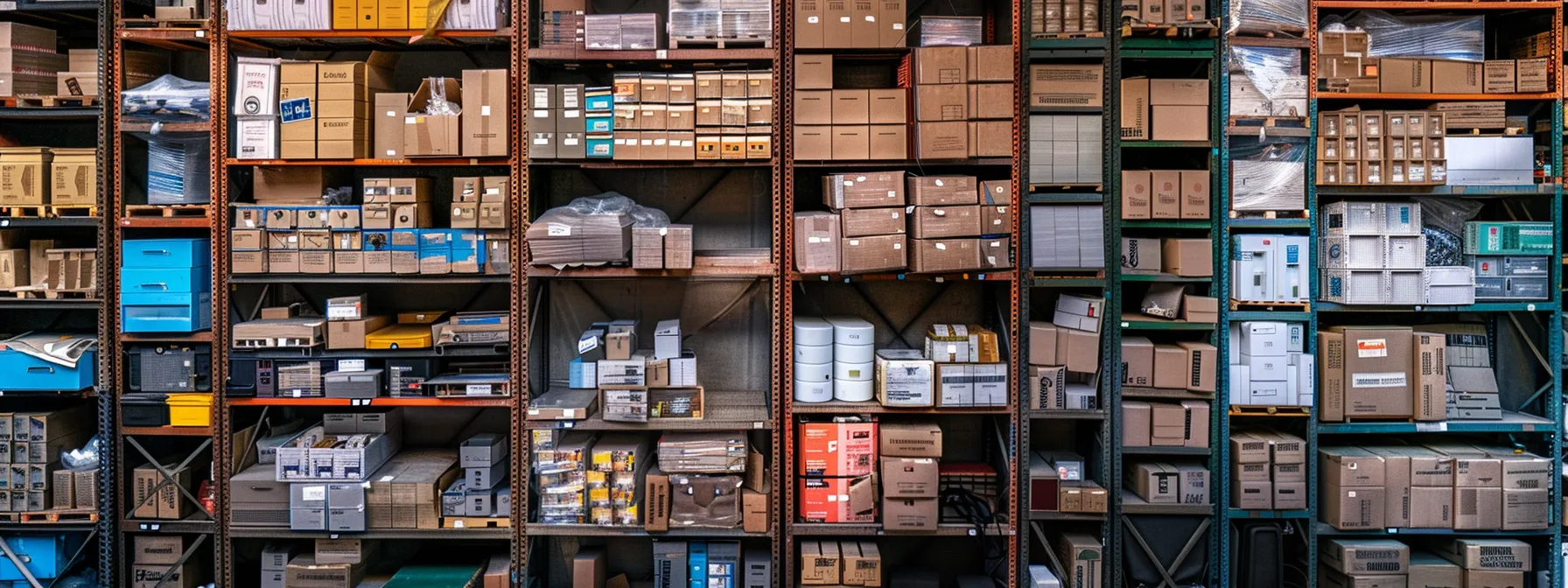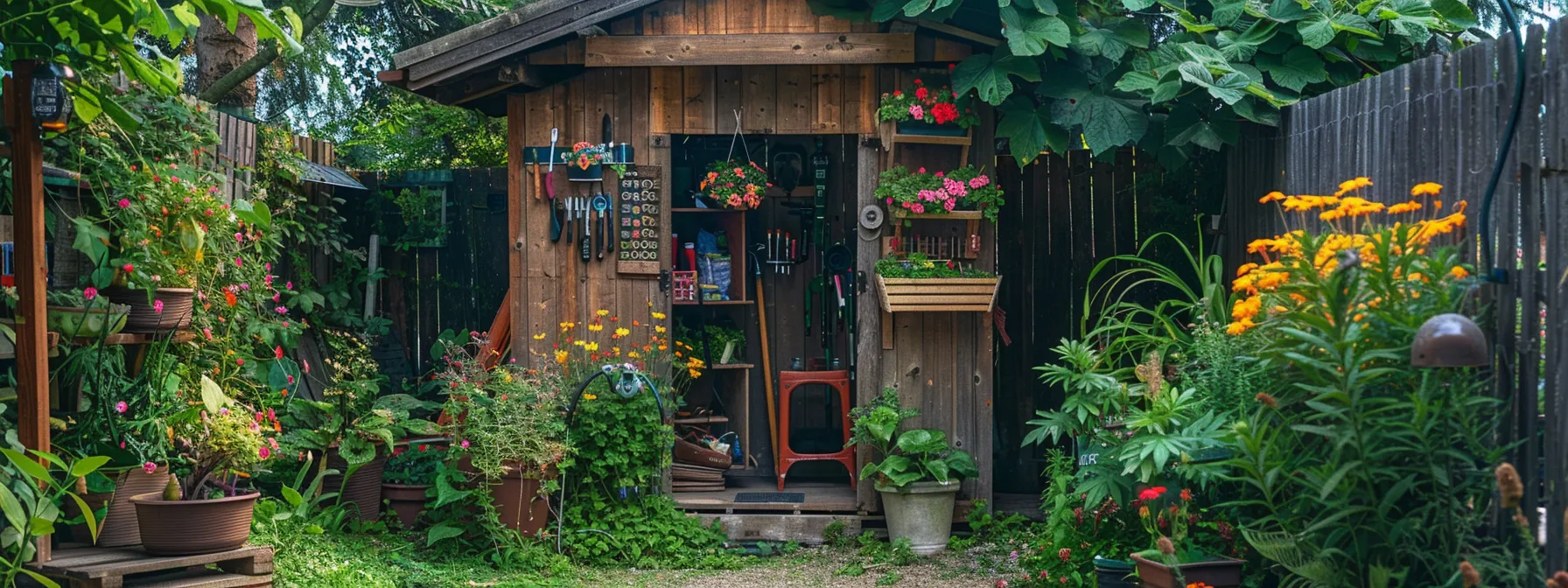Title: Space-Saving Strategies With Pallets for Storage Are you struggling to keep your space organized due to bulky storage solutions? This post unveils innovative strategies using pallets to create efficient storage systems. Readers will learn how to leverage vertical space with pallet racks, craft multifunctional furniture, and organize small items using pallet boxes and bins. Discover how these sturdy, space-saving solutions can transform cluttered areas into well-organized spaces, making the most of every square inch. Whether you’re dealing with heavy crates or seeking a metal shelf alternative, these pallet strategies are designed to alleviate your storage woes and maximize your space.
Key Takeaways
- Pallet racks must be chosen and installed to suit specific storage needs and space
- Proper preparation and use of materials are essential for durable pallet furniture construction
- Pallet boxes and bins improve organization and safety in storage environments
- Pallet accent walls and outdoor solutions creatively maximize available storage space
- Built-in storage in pallet benches offers a dual-purpose solution for outdoor clutter
Utilizing Pallet Racks to Maximize Vertical Storage Space

In the quest for efficient warehouse organization, assessing available wall space for pallet rack installation emerges as a critical first step. Selecting suitable pallet racks tailored to specific storage needs is paramount. Once chosen, the focus shifts to the secure installation of these racks, ensuring they are anchored firmly with screws and designed to support upcycling efforts. This approach not only optimizes wood and other materials but also enhances interior design, contributing to a streamlined, productive environment.
Assess Available Wall Space for Pallet Rack Installation
When considering the installation of pallet racks in a manufacturing setting, the assessment of available wall space is a crucial step. This process involves measuring the dimensions of the space and determining the type of racks that will best accommodate the storage of materials and products. It is essential to consider the workflow and the movement of trucks and automation equipment within the building to ensure that the racks enhance, rather than hinder, operational efficiency.
For businesses utilizing machine–heavy operations, the strategic placement of pallet racks can significantly impact productivity. The racks should be positioned to allow for easy access by machinery, such as forklifts, without compromising the safety and structural integrity of the building. This careful planning helps to prevent costly disruptions and maximizes the utility of the space for storage purposes.
Before the installation of pallet racks begins, one must consider the weight and size of the items to be stored:
This information will guide the selection of racks that are robust enough to support the weight and accommodate the dimensions of the items, ensuring a safe and organized storage system within the facility.
Select Suitable Pallet Racks for Your Storage Needs
When selecting pallet racking systems, one must consider the dimension of both the space and the goods to be stored. Racking designed to accommodate standard skids may not suffice for larger, irregularly shaped items or metal pallets. It is essential to choose a racking solution that not only fits within the physical confines of the warehouse but also supports the specific size and weight requirements of the stored products.
The durability and design of pallet racking are critical factors in ensuring efficient storage solutions. Metal pallets, for instance, require racking that can withstand their weight and frequency of use. A business must invest in high-quality racking that promises longevity and safety, thereby avoiding frequent replacements and potential inventory damage.
Optimizing warehouse space with the right pallet racking system directly impacts operational flow and productivity. By selecting racking that aligns with the dimensions of the storage area and the characteristics of the skids used, companies can enhance accessibility and streamline inventory management, leading to a more organized and effective workspace.
Install Pallet Racks Safely and Securely
Ensuring the safe and secure installation of pallet racks is a cornerstone of effective warehouse management. The process begins with a solid foundation, where each deck is anchored to the floor, capable of supporting the weight of loaded pallet plastic boxes and cargo. This foundational security is crucial for the integration of an automated storage and retrieval system, which relies on the stability of the racking to function efficiently.
Attention to detail during the installation phase can prevent future inventory losses and workplace accidents. Professionals must ensure that every beam and upright is properly aligned and locked into place, creating a robust structure that can withstand the dynamic forces of loading and unloading. This meticulous approach safeguards both the merchandise and the employees who navigate the storage area daily.
As businesses evolve, the adaptability of storage solutions becomes increasingly important. Pallet racks designed for versatility can accommodate various cargo sizes, and when installed with precision, they enhance the overall inventory management system. This flexibility, paired with a secure installation, ensures that the storage environment can meet the changing demands of the industry while maintaining safety and order.
Building Custom Pallet Shelves for Space Optimization

Maximizing storage efficiency in distribution centers begins with the strategic creation of custom pallet shelves. The process starts with gathering the appropriate tools and materials, ensuring each shelf is constructed to withstand the rigors of stock management. Designing pallet shelves to fit specific spaces within a trailer or warehouse requires careful inspection and planning. Once designed, the proper assembly and installation of these polyethylene-reinforced structures are crucial for optimizing space and enhancing the functionality of any storage environment.
Gather Tools and Materials for Pallet Shelving
Commencing the construction of custom pallet shelves necessitates a collection of specific tools and materials. A pallet truck is indispensable for moving heavy materials into position, while a comprehensive racking system ensures the secure assembly of the shelving units. The selection of high-quality, durable materials is crucial, as these shelves must withstand the daily demands of storage and retrieval, embodying the company’s commitment to efficiency and sustainability.
When gathering resources for pallet shelving, one must consider the lifecycle of the materials, emphasizing recycling and upcycling. By repurposing previously used pallets and integrating them into new racking systems, businesses demonstrate a dedication to environmental stewardship. This approach not only conserves resources but also contributes to the creation of furniture-grade shelving that is both functional and aesthetically pleasing.
Expertise in material selection plays a pivotal role in the longevity of pallet shelving. The use of robust polyethylene or similarly resilient plastics ensures that the shelves can bear the weight of stored items without compromise. This foresight in choosing the right materials translates into a racking system that offers reliability and peace of mind for businesses seeking to optimize their storage solutions.
Design Pallet Shelves to Fit Your Space
Designing pallet shelves to fit a specific space requires a keen understanding of the operational flow within a storage facility. For instance, shelves must be configured to allow forklift and crane access, ensuring that rackable plastic pallets can be easily moved without disrupting the workflow. This strategic design not only maximizes space but also supports the seamless integration of storage and retrieval systems.
When considering the design of pallet shelves, one must account for the dimensions and load capacity of rackable plastic pallets. The shelves should be constructed to accommodate the weight and size of these pallets, which are frequently handled by carts and lifting equipment. This foresight in design prevents overloading and maintains the integrity of the storage system.
The company’s expertise in crafting custom pallet shelves shines through in the attention to detail, ensuring that each rackable plastic pallet fits securely within the shelving unit. This precision not only optimizes space but also enhances safety, as the secure fit prevents shifting and potential accidents during the movement of goods. The design process, therefore, is a critical step in creating an efficient and safe storage environment.
Assemble and Install Pallet Shelves Properly
The assembly of pallet shelves requires precision and the right tools to ensure a sturdy construction. A drill is essential for securing components together, while a pallet jack facilitates the movement of the assembled shelves into their designated position. It’s crucial that each shelf is level and securely fastened to prevent any potential hazards in the storage area.
During construction, one must not overlook the importance of preparing the pallets themselves. Sandpaper is used to smooth out rough edges, reducing the risk of splinters and ensuring a clean finish. This preparation enhances the safety and durability of the shelves, making them suitable for long-term use in a busy storage environment:
Once the shelves are assembled, the installation process must be approached with care. The use of a level tool ensures that shelves are perfectly horizontal, a critical step for maintaining balance and preventing inventory from toppling. With the shelves securely anchored, the storage facility benefits from an optimized layout that maximizes space and improves operational efficiency.
Crafting Pallet Furniture for Multifunctional Storage

In the realm of space-saving solutions, crafting pallet furniture emerges as a versatile strategy for enhancing storage density. Whether in a garage, warehouse, or as part of a broader supply chain optimization, selecting the right pallet furniture designs is crucial. This section delves into the preparation of pallets for robust furniture construction, guiding readers through the process of building and finishing durable pallet furniture that meets export standards and complements their storage needs. Each step is designed to maximize utility and efficiency within the skid‘s lifecycle.
Choose Pallet Furniture Designs That Suit Your Needs
When selecting pallet furniture designs, one must consider the raw materials at hand and the intended use. For instance, a design that incorporates spaces for paint cans and tools is ideal for a creative studio, while a more robust construction using untreated wood may be better suited for heavy storage in an industrial setting. The design should facilitate easy access in narrow aisles and be durable enough to withstand the rigors of frequent use and shipping.
The choice of pallet furniture design can significantly impact the efficiency of space utilization. A well-crafted piece can transform an underused corner into a valuable storage area, optimizing the layout of the facility. It is essential to select designs that not only fit the physical space but also complement the workflow, allowing for quick and easy movement of goods and materials.
Businesses aiming to ship products or store items efficiently should prioritize pallet furniture designs that are easy to assemble and disassemble. This flexibility ensures that storage solutions can be adapted to changing needs without requiring extensive downtime or additional resources. The right design will offer a balance between functionality and ease of handling, streamlining the storage and transportation process.
Prepare Pallets for Furniture Construction
Initiating the construction of pallet furniture requires meticulous preparation of materials, a process where woodworking skills are paramount. The pallets, often crafted from durable wood or steel, must be inspected for integrity and strength to ensure they can bear the intended weight. This stage is crucial for creating stackable pallets that not only save space but also withstand the demands of logistics and storage.
Once the pallets are deemed suitable for use, the next step involves refining them for the construction process. Sanding down rough surfaces and removing any protruding nails or splinters are essential tasks that enhance the safety and aesthetics of the final product. These preparatory actions are vital for crafting furniture that is both functional and visually appealing, aligning with the practical needs of efficient storage solutions.
The transformation of raw pallets into multifunctional furniture pieces is a testament to the versatility of these materials within the logistics sector. By treating the wood or steel surfaces with appropriate sealants or paints, one can extend the lifespan of the furniture and protect it against the wear and tear of daily use. This attention to detail ensures that the stackable pallets not only optimize space but also contribute to a well-organized and sustainable storage environment.
Build and Finish Pallet Furniture for Durability
Building pallet furniture for durability begins with selecting the right materials. High-density plastic, known for its resilience in material handling, becomes an ideal choice for transport and storage solutions. This plastic ensures that furniture pieces can endure the rigors of movement and frequent use, making them a steadfast addition to any bathroom or garden setting.
The construction phase is critical; it demands precision and attention to detail. The joints and connections must be robust, ensuring that the pallet furniture can support significant weight and withstand the stresses of daily use. The following table illustrates the essential steps in constructing durable pallet furniture:
Once assembled, the finishing touches are what set apart high-quality pallet furniture. A protective coating or sealant is applied to shield the material from environmental factors, ensuring longevity whether the furniture is used in a transport setting or as a garden feature. This final step not only enhances durability but also provides a polished look that complements any space.
Organizing Small Items Efficiently With Pallet Boxes and Bins

Efficient organization of small items can transform a cluttered floor into a model of efficiency, and pallets play a pivotal role in this transformation. Creating pallet boxes for small item storage is a strategic approach to maximizing space, while labeling and categorizing items in pallet bins ensures quick identification. Arranging pallet boxes for easy accessibility streamlines the shipping and storage process. Each step, from using a tape measure for precise placement to selecting the right plastic storage pallets, is crucial for an orderly environment.
Create Pallet Boxes for Small Item Storage
Efficient storage solutions are paramount in reducing hazards and improving accessibility within a workspace. Pallet boxes are an excellent choice for organizing small items, as they consolidate unit loads and streamline the fulfillment process. By integrating these boxes into existing pallet racks, businesses can maximize vertical space and minimize clutter.
The design of pallet boxes should prioritize ease of access and the ability to withstand the dynamic environment of a busy warehouse. These storage containers enhance the functionality of pallet racks by allowing for quick retrieval and orderly management of small goods, which is essential for maintaining a high level of productivity in fulfillment operations.
Implementing pallet boxes in a storage system not only optimizes space but also contributes to a safer work environment. By providing a designated place for each item, the risk of accidents is significantly reduced, and the efficiency of unit load handling is increased, leading to a more organized and effective fulfillment center.
Label and Categorize Items in Pallet Bins
Efficient organization within a storage facility begins with the meticulous labeling and categorization of items in pallet bins. This system not only streamlines retrieval processes but also plays a crucial role in maintaining fire safety by ensuring materials, especially lumber, are stored correctly and accessibly. Clear labeling allows for quick identification, reducing the time spent searching for items and enhancing overall productivity.
Implementing a categorization system within pallet bins directly addresses the need for order in environments where small items are abundant. By grouping similar items together, such as hardware or small lumber pieces, and marking them with distinct labels, the company ensures a logical arrangement that facilitates swift inventory audits and restocking procedures. This methodical approach is essential for maintaining a high standard of fire safety, as it prevents the accumulation of clutter that could pose a risk.
The company’s expertise in storage solutions is evident in the use of actionable insights, such as the strategic placement of pallet bins to optimize space and ensure safety. For example, heavier items are stored on lower shelves to prevent strain and enhance stability, while lighter items occupy higher bins, all clearly labeled to minimize confusion and maximize efficiency:
Arrange Pallet Boxes for Easy Accessibility
Arranging pallet boxes for easy accessibility is a critical step in optimizing storage space and improving workflow efficiency. The company ensures that frequently used items are placed at an arm’s reach, while less commonly used materials are stored higher up or in less accessible areas. This strategic placement minimizes the time and effort required to locate and retrieve items, thereby enhancing productivity.
For the company, the layout of pallet boxes is designed with the user’s convenience in mind. Clear pathways are maintained between boxes, allowing for unobstructed movement and easy access with handling equipment such as pallet jacks. This thoughtful arrangement prevents congestion and facilitates a smoother operational process within the storage facility.
The company’s approach to organizing pallet boxes includes a systematic method to maximize space utilization and accessibility:
- Heaviest boxes are placed on the bottom to ensure stability and reduce lifting strain.
- Boxes containing items in high demand are positioned at the front of the storage system for quick access.
- Labels are prominently displayed on each box, enabling immediate identification and retrieval of contents.
By implementing these practices, the company not only streamlines the storage process but also creates a safer and more organized environment for staff, which in turn leads to a more productive and efficient operation.
Creating Pallet Accent Walls for Innovative Storage Options

Innovative storage solutions are essential for maximizing space, and pallet accent walls offer a creative and practical approach. Planning the design of a pallet wall is the first step to ensuring maximum storage capacity. Preparing the wall surface for pallet installation is crucial for a secure and lasting setup. Finally, attaching pallets to the wall securely guarantees stability and safety. These steps provide a foundation for transforming walls into efficient storage areas, optimizing space in any setting.
Plan Your Pallet Wall Design for Maximum Storage
When planning a pallet wall design, the primary objective is to maximize storage while maintaining a streamlined aesthetic. The design should account for the dimensions of the space and the types of items to be stored, ensuring that the pallet wall serves as a practical extension of the storage area. By considering the weight distribution and accessibility, one can create a pallet wall that not only saves space but also supports efficient organization.
Expertise in spatial design is evident when pallet walls are crafted to accommodate a variety of storage needs. For instance, a pallet wall in a retail setting might integrate shelves of varying depths to display products attractively, while in a warehouse, the focus might be on creating uniform bays for easy pallet access. The design must be tailored to the specific requirements of the environment, optimizing the use of vertical space and enhancing the functionality of the area.
Ensuring the durability of a pallet wall is crucial for long-term storage solutions. The design should incorporate high-quality materials and a robust anchoring system to withstand the demands of stored goods. This approach not only guarantees the safety and stability of the wall but also instills confidence in its ability to serve as a reliable storage option for years to come.
Prepare Wall Surface for Pallet Installation
Before the installation of pallet accent walls, it is essential to prepare the wall surface meticulously. This preparation involves cleaning the wall to remove any debris or dust that could compromise the stability of the pallets. The company ensures that the surface is smooth and even, which is critical for the secure attachment of the pallets and the longevity of the installation.
Next, the company assesses the wall’s structural integrity to determine the best method for anchoring the pallets. This step includes locating studs within the wall, as these will provide the support needed to hold the weight of the pallets and the items stored on them. The use of a stud finder is a practical example of the tools employed to ensure a safe and effective installation:
- Locate and mark the position of studs for secure anchoring.
- Measure and mark the areas where the pallets will be attached.
- Drill pilot holes to facilitate the insertion of screws or bolts.
Finally, the company prepares the necessary hardware, such as screws or mounting brackets, to attach the pallets securely to the wall. This hardware is selected based on the type of wall material and the expected load on the pallets, ensuring a robust installation that meets the storage needs of the facility. The company’s expertise in this process guarantees that the pallet accent walls will be a durable and space-efficient addition to any storage environment.
Attach Pallets to Wall Securely
Securing pallets to a wall is a task that demands precision and strength to ensure a safe and enduring storage solution. The company uses heavy-duty fasteners, such as lag bolts or structural screws, which are driven into the wall studs to provide a stable foundation for the pallets. This method of attachment is crucial for preventing any movement or sagging over time, offering peace of mind that the storage system is reliable.
For added stability, the company often employs metal brackets or mounting plates at the corners of each pallet. These reinforcements distribute the weight evenly and reduce the strain on individual fasteners, extending the lifespan of the storage setup. The use of such hardware exemplifies the company’s commitment to creating storage solutions that are not only space-efficient but also exceptionally secure:
Once the pallets are securely attached to the wall, the company conducts thorough inspections to ensure the integrity of the installation. This includes checking for any loose components and verifying that the pallets are level and flush against the wall. Such diligence ensures that the pallet accent walls are not only functional but also safe for both employees and the stored items.
Implementing Outdoor Pallet Storage Ideas for Extra Space

Expanding storage capabilities extends beyond the confines of indoor spaces. Outdoor pallet storage solutions offer innovative ways to declutter and organize. Building pallet sheds provides a dedicated area for garden tool storage, while creating pallet planters introduces vertical gardening to maximize space. Constructing pallet benches with built-in storage merges functionality with leisure, offering a dual-purpose solution. Each strategy leverages the versatility of pallets to enhance outdoor areas efficiently.
Build Pallet Sheds for Garden Tool Storage
Building pallet sheds for garden tool storage is a practical and cost-effective way to extend outdoor storage space. These structures, crafted from durable pallets, provide a sheltered environment to protect tools from the elements. The company’s expertise in utilizing pallets for construction ensures that each shed is not only functional but also blends seamlessly with the outdoor aesthetic.
The design of pallet sheds can be customized to fit the specific storage needs and space constraints of any garden. By employing pallets in the construction, the company offers a flexible solution that can be easily expanded or modified as storage requirements evolve. This adaptability makes pallet sheds an ideal choice for gardeners looking for a scalable and efficient storage option.
For those seeking to organize their outdoor spaces, pallet sheds present an opportunity to declutter and streamline garden tool storage. The company’s approach to building these sheds focuses on maximizing space while maintaining easy access to tools. This results in a tidy and well-organized garden area, allowing for a more enjoyable and productive gardening experience.
Create Pallet Planters for Vertical Gardening
Vertical gardening with pallet planters is an innovative approach to maximizing outdoor space while fostering a green environment. These planters utilize vertical space on walls or fences, transforming them into lush, living displays. The company’s expertise in repurposing pallets into garden features ensures that each planter is not only functional but also enhances the aesthetic appeal of any outdoor area.
For those with limited ground space, pallet planters offer a solution to grow herbs, flowers, or even small vegetables. The company designs these space-efficient planters to provide ample growing room in a compact footprint, addressing the needs of urban gardeners and patio enthusiasts alike. The use of pallets in creating these planters demonstrates a commitment to sustainable practices by repurposing materials that might otherwise go to waste.
The process of creating pallet planters involves several key steps to ensure durability and ease of use:
- Selecting heat-treated pallets to avoid chemical contamination.
- Applying a weather-resistant finish to protect against the elements.
- Installing a fabric backing to contain soil and retain moisture.
By following these steps, the company crafts pallet planters that not only optimize outdoor space but also contribute to a more sustainable and productive gardening practice. These vertical gardens serve as a testament to the versatility and utility of pallets in creating effective storage and growing solutions.
Construct Pallet Benches With Built-in Storage
Constructing pallet benches with built-in storage is a clever approach to enhancing outdoor spaces while addressing clutter. These multifunctional pieces serve as comfortable seating while offering a hidden compartment for garden tools, cushions, or recreational equipment. The dual-purpose design maximizes space efficiency, making it an ideal solution for patios or gardens with limited square footage.
The company’s expertise in pallet utilization is evident in the sturdy construction of these benches. Each bench is crafted to withstand outdoor conditions, ensuring longevity and durability. The built-in storage feature provides a practical solution for organizing and protecting outdoor essentials, thereby reducing visual clutter and optimizing the use of available space.
For those interested in adopting this space-saving strategy, the company provides a simple guide to constructing pallet benches with storage:
- Select quality pallets suitable for outdoor use.
- Customize the bench size to fit the intended outdoor area.
- Integrate a hinged seat top for easy access to the storage compartment.
Conclusion
Pallets offer innovative and adaptable solutions for maximizing storage space, both indoors and outdoors. By customizing designs to fit specific needs, pallets can transform underutilized areas into efficient storage systems, enhancing organization and productivity. The strategic use of pallets in creating furniture, accent walls, and planters not only optimizes space but also contributes to a sustainable approach in material handling. Embracing these space-saving strategies with pallets is essential for businesses looking to streamline operations and manage inventory effectively.
